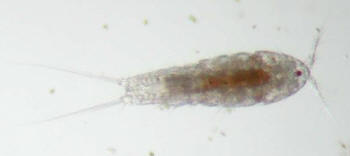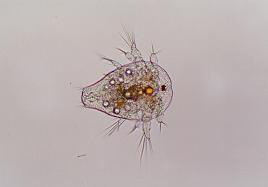
By Adelaide Rhodes, Ph.D.
You've heard of them, you know
they're good, but what exactly are "Copepods"? Do you have them in your
tank? Do you want them in your tank?
 |
|
Adult
Copepods average 237 microns in length.
Photo Copyright 2000, Adelaide Rhodes, North Carolina State University. |
Basically, Copepods are microscopic
crustaceans that form an essential link in the marine food web. They graze
on phytoplankton, bacteria, and in some cases, detritus. They incorporate
the protein and fatty acids from these food sources and concentrate it into a
highly nutritious packet of food for consumption by marine fish and
invertebrates.
The
beneficial effects of consuming fish oil are well known, and this is linked to
the nutrition that Copepods provide ocean-dwelling fish. Some of the
essential fatty acids that make fish oils so nutritious are derived from the
copepods eaten by these fish species. Many marine fish, especially in the
larval stage, cannot survive without the fatty acids found in copepods, hence
the name "essential" fatty acids. Therefore, Copepods are a vital source of
these essential fatty acids which end up in the fish oil humans consume.
It is difficult to believe that
something so small could have such a significant impact on the nutritional value
of fish, but a good analogy is the dependence of whales on krill. Krill
are just another type of marine crustacean rich in essential fatty acids, and
the preferred food of many species of whale, which filter the krill out of the
water by pushing them through the fine mesh of baleen found inside their mouths.
Without the krill, the whales would die. Think of the size of the whale
compared to the krill and you can begin to see how significant Copepods can be
in the marine food web.
Most hobbyists have introduced
Copepods to their tank at one time or another by accident or design. Those
little white bugs which stick to the glass or are attracted to a light entering
the side of the tank are mainly Copepods. It's easy to confuse Amphipods
with Copepods, but there are a few ways to tell the difference. First, if
you can stand across the room and see it, it's an Amphipod. Additionally,
if it looks like a swimming comma, and hangs out where it can be seen easily,
it's an Amphipod.
Copepods are not often seen until
they become super-abundant and swarm somewhere where they are easily visible.
The small size of Copepods and their behavior make them an ideal food source for
some picky eaters, such as Seahorses and Mandarin Gobies. Fish that like
to pick off the rocks or stick their noses in the sand are also grazing on
Copepods, even though you may not see what they are picking. An advantage
of the Copepods' small size is that they, in turn, can consume super small
particles of algae, bacteria, and detritus, helping to keep your tank clean.
Copepods are one of the desirable species which hitchhike on your live rock or
hang out in your refugium. The presence of Copepods can keep your tank healthy
and stable.
Many hobbyists only become aware of
the need for Copepods in their systems when they introduce one or more fish
species which require these creatures as a part of their diet. These fish will
often graze down the resident population, and if they are especially picky
eaters, they can become dependent on a continuous supply of Copepods. This
is not usually a problem if the Copepods in your system are able to keep up with
the grazing activity by reproducing and repopulating quickly, or if you have a
separate area where the Copepods can live and thrive such as a sump or refugium.
Even with the most balanced systems, it may be necessary to reseed the tank with
a viable population of quickly-reproducing species to compensate for the grazing
activity.
Not all Copepods are the same. There are 12,000 species out there, and
many are parasitic, so it's important to be choosy about what you put in your
tank. There are three types of Copepods that are free-swimming and make
good fish food: Calanoid, Harpacticoid, and Cyclopoid. Cyclopoid
species are mainly freshwater, and don't play as much of a role for hobbyists as
the other two types. Calanoid species are mainly swimmers - they can spend
their entire life cycle in the water column once they hatch from eggs.
They have large frilly antennae and dart very quickly when startled.
Harpacticoids are "epibenthic", meaning that they spend part of their life cycle
or time during the day on the bottom or clinging to a surface. Their
antennae are much shorter than their body length and they look like little
torpedoes. They tend
to carry their eggs in big sacs, which can be visible to the naked eye.
They do not swim as quickly as Calanoids, making them easier to capture as a
food.
While Calanoid species are highly desirable, they are much more difficult to
maintain in a tank system because of the delicate nature of their antennae and
preference for live phytoplankton as a food. Calanoids will quickly die
due to temperature or salinity changes. Harpacaticoids are a little
hardier, and while they do not spend all of their time in the water column, they
are present for a sufficient period of time for fishes to find and consume
them. Their epibenthic behavior also gives them an advantage in the tank
environment because enough of them can hide from their predators where they can
continue to thrive and reproduce. Harpacticoid Copepods can also subsist
on diets other than live phytoplankton and have the added advantage of keeping
the tank clean by grazing on leftover fish food, bacteria, and other detritus.
Harpacticoid Copepods are also not as sensitive as Calanoids, because they have
had to eek out their existence in highly variable environments such as estuaries
or tide pools. The little white bugs in hobbyists' aquariums either fall into
the Calanoid or Harpacticoid category.
It is difficult to find a starter culture of Copepods these days, but there are
more and more sources popping up on the web. Many aquarists have friends
who seem to have a thriving population in their sump or refugium - this is a
readily-available and cheap source. However, if you are intending to buy
Copepods some questions to ask yourself are: What will eat them? What
size are they? Are they wild-caught or raised in a lab? Have they
been shown not to be harmful to my fish? Are they a delicate species,
difficult to care for, or one that can just adapt readily whatever the
situation?
I have spent a lot of time thinking about these issues when developing products
for Essential Live Feeds, and here are a few pointers. Basically, Copepod
users fall into two categories: fish breeders and hobbyists. If you
are a breeder of Clownfish or other tropical species, you may want to
consider having a pure culture of one particular species so that you can test
reliably whether rearing larvae with the Copepods is an improvement over rearing
them with rotifers or Artemia.
 |
|
Copepod Nauplii |
You may want to set up a separate culture system such as the one described by
Frank Marini. To make sure that you have enough Copepods to sustain the
fish throughout their early life stages, a good rule of thumb is having 2 prey
items per mL for larval fish. A 10 gallon tank would require about 60,000
Copepods if that is going to be the only prey item. It can take about 1
month to rear that quantity from a starter culture of 2,000 Copepods.
Hobbyists that just have a simple
tank system with a variety of critters to feed can use Calanoid or
Harpacticoid Copepods as a simple addition to their tank system in order
to create a mini-ecosystem. Copepods can become a natural part of the
environment once introduced to the tank, and do not require any additional
feeding or care. I offer a mixed culture of 3 species through
oceanpods.com that are much less expensive than the pure cultures offered
through Essential Live Feeds (ordered through Reed Mariculture), because mixed
cultures are less costly to maintain. Utilizing Copepods is one of the
many things that the hobbyists can utilize to enhance a reef system. So,
the availability of this type of product makes Copepods more accessible to the
average hobbyist. I find that hobbyists become as enthusiastic about the
variety of Copepods in their tanks as they are about the fish and corals they
are able to maintain by utilizing them as a food source! I'm sure many
hobbyists have read of the potential difficulties of feeding notoriously picky
eaters such as Mandarin Gobies, etc., so having Copepods can definitely increase
the odds of success with these fishes.
I am happy to offer assistance to anyone out there who is struggling to maintain
a Copepod population, whatever the source. Please feel free to contact me
at
adelaide@essentiallivefeeds.com with
your questions and concerns. Also, I am always adding to the FAQ at
www.essentiallivefeeds.com and www.oceanpods.com, so I'd like to hear about any
great Copepod-related sites that you think should be posted.
